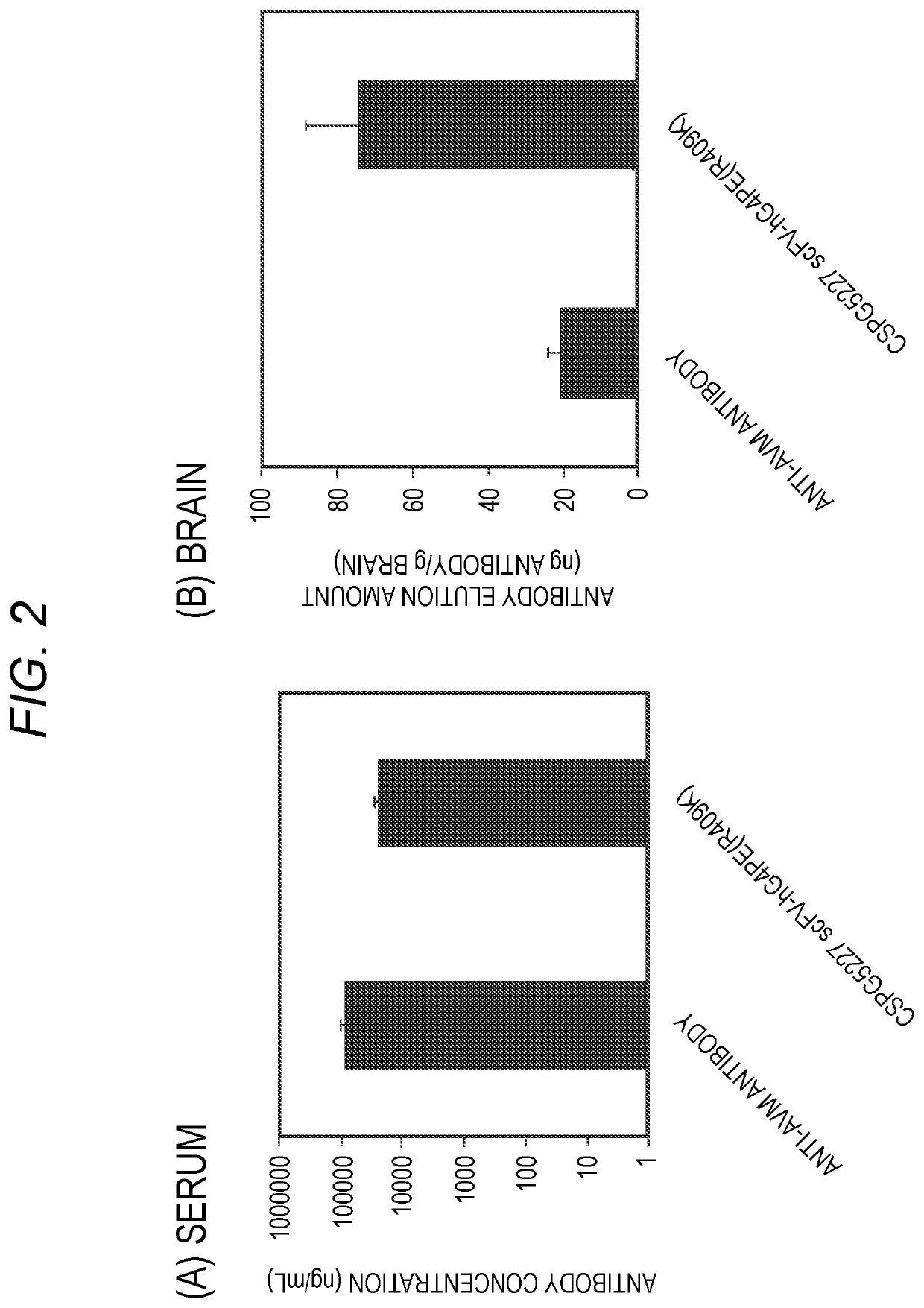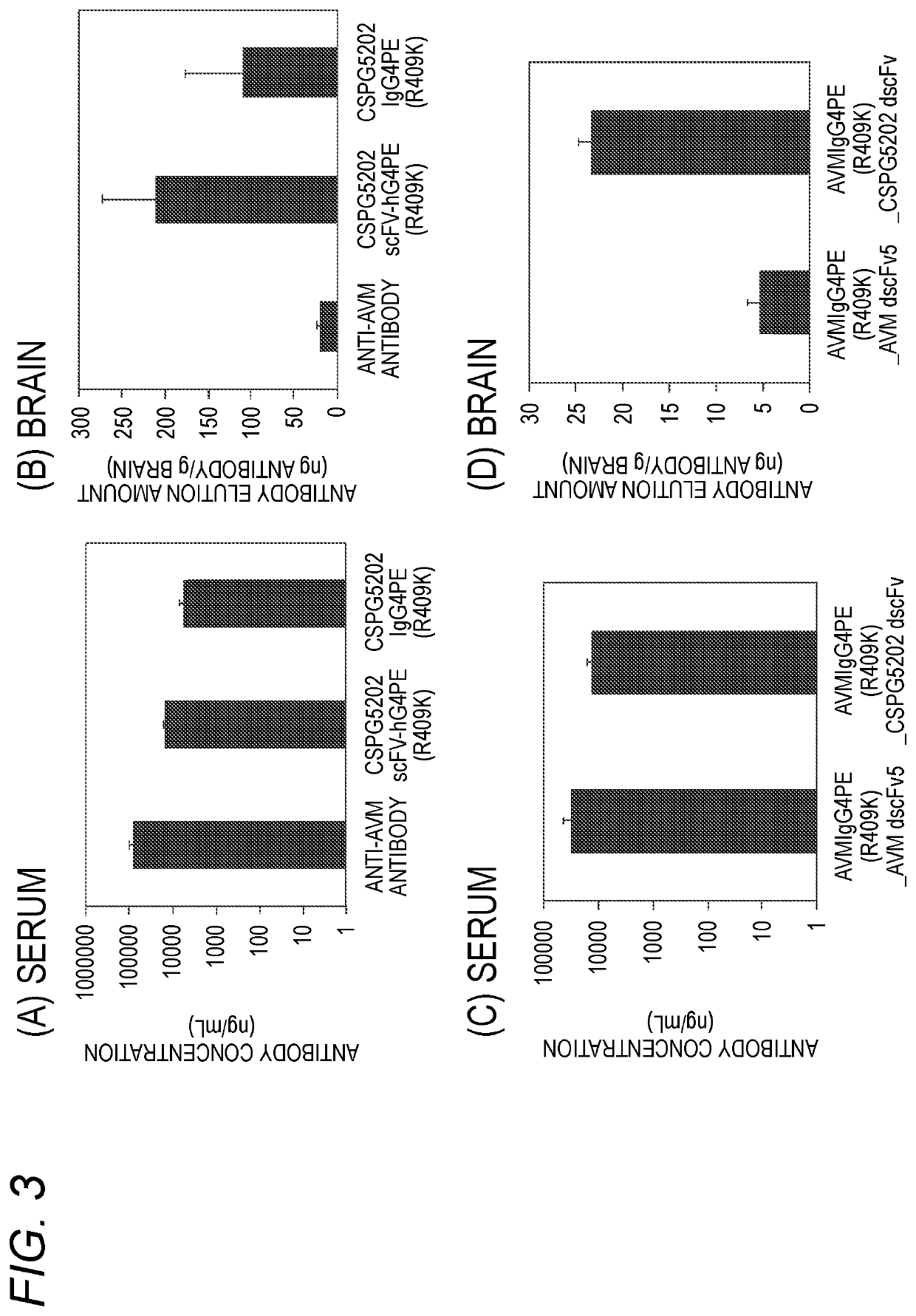Antibody binding to chondroitin sulfate proteoglycan 5
a technology of chondroitin sulfate and proteoglycan, which is applied in the direction of instruments, fusions for specific cell targeting, and fusions, etc., can solve the problems of difficult drug development, high invasive direct administration into the medullary cavity or the brain, and inability to obtain effective concentration at the time of drug administration, etc., to achieve the effect of enhancing the property of accumulation
- Summary
- Abstract
- Description
- Claims
- Application Information
AI Technical Summary
Benefits of technology
Problems solved by technology
Method used
Image
Examples
example 1
[Example 1] Acquisition of Anti-CSPG5 Antibody
(1) Acquisition of Antibody Using Human Antibody Phage Libraries
[0508]A VH gene fragment and a VL gene fragment were amplified from human PBMC-derived cDNAs by PCR. Each of the VH gene fragment and the VL gene fragment was inserted into a phagemid vector pCANTAB 5E (manufactured by Amersham Pharmacia Biotech, Inc.), and plasmids were obtained by transforming E. coli TG1 (manufactured by Lucigen Corporation). The obtained plasmids were infected with M13K07 Helper Phage (manufactured by Invitrogen, Inc.), whereby human antibody M13 phage libraries of the VH gene and the VL gene were obtained.
[0509]In addition, a synthetic human antibody M13 phage library in which random mutations were introduced into CDR3 was produced in the same manner.
[0510]By using the human antibody M13 phage libraries, anti-CSPG5 monoclonal antibodies were obtained using the phage display method described below. Human CSPG5-FLAG_Fc or mouse CSPG5-FLAG_Fc of Example 4 ...
example 2
[Example 2] Production of Antibody
[0517](1) Construction of CSPG5 scFv-hG4PE(R409K) Expression Vector
[0518]An expression vector was constructed for producing a scFv-Fc antibody in which each anti-CSPG5 scFv antibody was bound to the Fc region of a human IgG4 antibody comprising amino acid residue substitutions of S228P, L235E, and R409K according to the EU numbering (hereinafter sometimes abbreviated as “IgG4 variant”).
[0519]The gene fragment of the scFv region was amplified by PCR using the phagemid vector pCANTAB_CSPG5115 as a template. The gene fragment of the Hinge-CH2-CH3 region was amplified by PCR using a synthetic gene of the heavy chain constant region as a template. The obtained gene fragments were inserted into a pCI vector (manufactured by Promega, Inc.), whereby a pCI_CSPG5115 scFv-hG4PE(R409K) vector was produced.
[0520]Antibody expression vectors in which the gene fragment of the scFv region of each of the various types of anti-CSPG5 antibodies shown in Table 1 was int...
example 3
[Example 3] Analysis of Reactivity with CSPG5-Expressing Cells
[0528]The nucleotide sequence encoding human CSPG5 is represented by SEQ ID NO: 159, an amino acid sequence deduced from the nucleotide sequence is represented by SEQ ID NO: 160, the nucleotide sequence encoding mouse CSPG5 is represented by SEQ ID NO: 161, an amino acid sequence deduced from the nucleotide sequence is represented by SEQ ID NO: 162, the nucleotide sequence encoding monkey CSPG5 is represented by SEQ ID NO: 163, and an amino acid sequence deduced from the nucleotide sequence is represented by SEQ ID NO: 164.
[0529]The full-length gene sequences of human CSPG5, mouse CSPG5, and monkey CSPG5 were synthesized, and the gene sequences were each inserted into the BamHI-NotI site of a pEF6 / V5-His (manufactured by Thermo Fisher Scientific, Inc.) vector, whereby the following plasmid vectors for membrane expression of the respective types of CSPG5: pEF6_human CSPG5, pEF6_mouse CSPG5, and pEF6_monkey CSPG5 were produ...
PUM
| Property | Measurement | Unit |
|---|---|---|
| Fraction | aaaaa | aaaaa |
| Fraction | aaaaa | aaaaa |
| Affinity | aaaaa | aaaaa |
Abstract
Description
Claims
Application Information
 Login to View More
Login to View More - R&D
- Intellectual Property
- Life Sciences
- Materials
- Tech Scout
- Unparalleled Data Quality
- Higher Quality Content
- 60% Fewer Hallucinations
Browse by: Latest US Patents, China's latest patents, Technical Efficacy Thesaurus, Application Domain, Technology Topic, Popular Technical Reports.
© 2025 PatSnap. All rights reserved.Legal|Privacy policy|Modern Slavery Act Transparency Statement|Sitemap|About US| Contact US: help@patsnap.com



